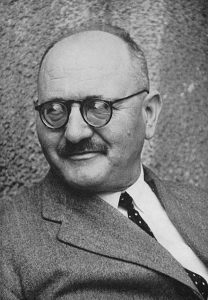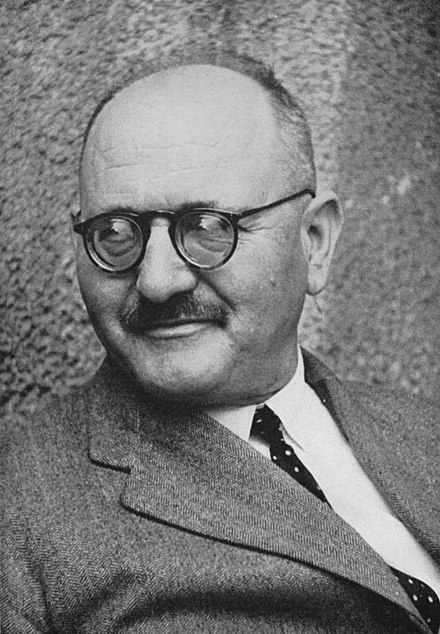
Andrija Štampar (1888-1958), a public health reformer, physician, and leading international health expert from the former Yugoslavia, left a lasting impact on both national and international public health policies and laws. Recognized “from Peru to China” and renowned as a “peasant advocate” by his Chinese colleagues, Štampar’s legacy is closely associated with the World Health Organization and its promotion of universal healthcare through international cooperation. Less well-known, however, is Štampar’s adaptation of socio-medical principles to rural localities, achieved through international laws and policies and bolstered by his influence on medical education in Yugoslavia and beyond.
Upon receiving the Leon Bernard Foundation Prize at the 8th World Health Assembly in 1955, attended by delegates from over 80 countries, Štampar reflected on the formative influences of his medical career. As the son of a village schoolteacher, he explained that the people of Drenovac, where he lived and trained as a physician, were his "first and best teachers;" he “learned from them to look upon life realistically.” Štampar’s approach to health policies, national health administration laws, and standards, which were based on the social and economic conditions of life, placed him firmly in the camp of social medicine advocates rather than proponents of individual therapy. Given that much of Yugoslavia and the world lived in rural areas, Štampar consistently sought to address the question of how medical practice could improve the lives of all citizens, including peasants. Through his observations of health standards, habits, and living conditions in the countryside, Štampar analyzed how the housing, sanitation, education, and nutrition standards of his compatriots influenced health outcomes.
As a result, Štampar became convinced that improving health conditions required looking beyond the field of medicine and connecting health with broader social and economic reforms. After completing his medical degree in Vienna in 1912, Štampar spent the next four decades advocating for international collaboration between physicians, engineers, economists, and educators, positioning health as a vital element of state-building, modernization, and human rights.
The establishment of the new Kingdom of Serbs, Croats, and Slovenes in 1918 allowed Štampar to put his public health ideas into practice by establishing healthcare laws and bureaucracies from scratch. In 1919, he was appointed Head of the Department of Hygiene and Social Medicine at the Health Ministry in Belgrade and an Assistant Professor of Social Medicine at the University of Zagreb. During his ten years of work in the interwar Yugoslav Kingdom, as the country was renamed after 1929, Štampar established a network of over 250 institutions, enforced essential healthcare laws, increased the number of physician-hygienists, reduced general mortality, significantly lowered the occurrences of infectious diseases, and augmented the number of physicians working abroad. Among the most significant legal projects he spearheaded were a treaty on social therapy, the reform of health institutions, the reform of medical education, and the introduction of a new national health law.
It was the efficient and effective organization of public health administration through a decentralized and participatory health center scheme that proved to be essential to Štampar’s global success, influencing international healthcare provisions for decades to come. The foundation of this system was the ‘primary health center,’ ideally located in every village, which organized dispensaries for children, administered vaccinations, and facilitated education in hygiene. Secondary health centers in smaller towns supervised the network of these smaller health institutions. Additionally, a District Health Center (one per 100,000 inhabitants) and a Public Health Institute performed supervisory functions.
Targeted state reforms supported this emerging health system network. One such reform was the formulation of social insurance laws as a prerequisite for a universal healthcare system, which Štampar estimated would take 30-40 years to fully operationalize. Collaborating with agricultural experts and economists, Štampar and his colleagues from Zagreb and Belgrade advocated for incentivizing peasants to participate in health insurance schemes by linking them to widespread networks of agricultural cooperatives.
The second method for increasing local participation in healthcare programs was involving them in the operations of health centers. A peasant university, like the one established in Zagreb in 1927, began offering courses to train local peasants to work alongside doctors and nurses in primary health centers, administering first aid and prophylaxis. These peasant-doctor schemes left a lasting impact on the history of public health by inspiring Mao Zedong’s barefoot doctor scheme in China.
For Štampar, the success of his health center scheme was part of a larger project to revitalize rural life, which he first pursued in Yugoslavia and then internationally. Through the model villages of Slavkovica and Mraclin, Štampar demonstrated the importance of environmental sanitation and housing in improving health outcomes, attracting the attention of leading health experts, including the directors of the Rockefeller Foundation. By 1921, the impact of these initiatives had reached as far as West Bengal, where Rabindranath Tagore founded the Institute for Rural Reconstruction using Yugoslavian village projects as a template. By the mid-1930s, the health center scheme had become an international standard as the most effective and efficient method for universalizing access to healthcare services for rural populations.
Štampar was not alone in the efforts to improve the living standards of rural communities. Following successful regional cooperation through the ‘Little Health Entente,’ Štampar and his colleagues from Central-Eastern Europe, including LNHO Medical Director Dr. Ludwik Rajchman, turned their attention to the League of Nations Health Organization. These health reformers posited that social medicine, based on universal healthcare access and standards but pragmatically adapted to the conditions of life in rural localities, could become a global vehicle of modernization.
As a result of his success in Yugoslavia, Štampar became a leading international rural health expert employed by the League of Nations Health Organization (LNHO). Although he is better known for his work on the rural reconstruction project in China (1933-1936), Štampar's legacy in international law lies in his contributions to rural hygiene and rural life projects of the LNHO. In 1931, Štampar prepared the report and led discussions on the most efficient and effective organization of healthcare services in rural districts at the European Rural Hygiene Conference in Geneva. With support from his colleagues in Central-Eastern Europe, Štampar helped establish the health center as a global international standard. At the conference, regional experts successfully argued for the decentralization of healthcare services based on Štampar’s report, which highlighted the efficiency of the health center model, the integration of healthcare with agricultural cooperative work, and the participation of peasants in healthcare schemes.
The conference recommendations solidified the integrative approach to rural health as an international standard. Professor Jacques Parisot, chairman of the LNHO Health Committee in 1935, praised the universal success of the health center scheme, noting that it was “couched in terms sufficiently general to allow their extensive application, while sufficiently definite to be of real utility and afford valuable guidance for effective and economical health administration in the rural environment.” The objective of improving health outcomes extended beyond physicians to include priests, teachers, engineers, sanitary experts, and economists. This led to reframing the LNHO’s ‘rural hygiene’ projects into ‘rural life’ projects. The first Rural Life Conference, held in Bandung in 1937, was inspired by the European meetings of half a decade earlier. In the same spirit as the Central-Eastern European medical reformers, the Far Eastern delegates advocated for decentralizing health services and integrating healthcare with agricultural and rural reconstruction work, demonstrating the global appeal of this ‘welfarist’ or ‘modernization’ focused view on health.
To safeguard the achievements of the Rural Hygiene and Rural Life conferences, Štampar and his colleagues fought to expand the LNHO’s standard for measuring the quality of life in rural areas. In addition to the established quantitative measures of rural life standards, known as ‘indices of health and vitality’ (mortality, morbidity, natality), they introduced new qualitative categories. These more holistic measures included ‘indices of public health activity’ and ‘indices of the rural environment.’ This comprehensive set of criteria was a blueprint for national reports and monographs on rural life, which began arriving on Geneva desks in 1939.
Štampar's influence on LNHO activities extended beyond rural life projects. Between his three years in China, Štampar organized and supervised the International Rural Housing Exhibition in Paris in 1937 and led the comparative maternal and infant welfare studies of the LNHO. His work laid the foundation for improving maternal, prenatal, and postnatal care standards by establishing visiting fellowships and exchange programs. Although World War II put a hold on the further globalization of Rural Life initiatives by canceling the planned conference in Mexico City in 1940, Štampar continued to champion international health policies and laws after 1945. Shortly after returning from his imprisonment in Graz, Štampar took the post of Dean of the Faculty of Medicine in Zagreb and continued his work as an international health expert in the WHO.
As vice-chairman of the Economic and Social Council of the United Nations and chairman of the Interim Commission of the WHO, established in 1946, Štampar led the WHO through its most tumultuous and insecure years. He impartially navigated geopolitical tensions between the USA and USSR and their allies with an aura of a “crusader of unanimity,” according to the Times. Štampar influenced the drafting of the preamble to the WHO constitution in 1946, referred to as “the Magna Carta for health,” highlighting the interconnected nature of health to other socio-economic conditions of life and health as an “attainable standard.” Health thus became “one of the fundamental rights of every human being without distinction of race, religion, political belief, economic or social condition.”
After shaping the WHO’s preamble, which set forth the principles and guiding motives of the organization, Štampar influenced international health laws in two distinct ways: by initiating the model of technical discussions to guide yearly World Health Assemblies and by establishing the Committee on Medical Education. The former initiative became a vehicle for reviving some of his leading rural health initiatives of the interwar years. Reflecting on his activities in the international sphere after 1945, Štampar noted that he proposed adopting ‘rural health’ as the central theme of the Seventh World Health Assembly technical discussions in 1954, where he also served as a leading reporter. The latter forum, initiated by Štampar during his tenure as a WHO Executive Committee member (1948-1951), allowed him to advocate for the importance of practical education and socio-medical work in training physicians and nurses. As a result of these technical discussions at the WHA, the WHO established the Special Medical Education Committee, leading to the First Conference on Medical Education in London in 1953.
Štampar’s actions on national Yugoslav medical education laws were equally impressive, albeit focused on the People's Republic of Croatia. He managed to carve out a degree of independence for his socio-medical work, which did not always align with the Communist Party of Yugoslavia’s federative policies. His most outstanding achievement was ensuring the survival of the School of Public Health in Zagreb by integrating its function with the Medical Faculty in Zagreb, which he oversaw. Reflecting Štampar’s integrative view on health and the importance of training physicians in social medicine, the school offered six postgraduate courses: nursing, sanitary engineering, industrial medicine, anesthesiology, and the two most popular courses, social pediatrics and public health. The school closely collaborated with the WHO by organizing a three-month course in industrial medicine in English, attended by 15 health workers from various European countries.
Continuing his work on social medicine, rural health, and medical education reforms, Štampar became a leading consultant for the WHO, UNICEF, and UNESCO. In 1955, he led two public health administration seminars—one in Sudan and Egypt and another in Scotland, Sweden, and Belgium—as part of the WHO’s public health administration (PHA) programs, which accounted for a significant portion of the organization’s budget. During this time, he contributed to reorganizing medical faculties and establishing health centers in Afghanistan and Ethiopia in 1955 and 1957, combining his passion for medical education and rural health.
Štampar's sudden death in 1958 left a void in the international health community. His good friend and colleague, Henry van Zile Hyde, who worked with him at the WHO, reflected on this significant loss for the transnational community of health experts: “Štampar was a man of force and conviction. He had worked effectively under the monarchy and under the Tito regime. No one seemed quite to know his politics because perhaps his politics were only people and their needs. Untold millions who have never heard of him have lost a friend who worked for them incessantly and stubbornly, who fought for them valiantly.” Thanks to Štampar’s influence on national health laws and the constitution and functions of the WHO, his work on incorporating social medicine, caring for the health of rural inhabitants, and training a new generation of physicians to understand the needs of the people lives on today, beyond the work of the School of Public Health in Zagreb, which bears his name.
Nicole Albrecht (Birkbeck, University of London/Georgetown University)
Bibliography
-
Dugac, Željko, Stella Fatović-Ferenčić, Luka Kovačić, and Tomislav Kovačević. ‘Care for Health Cannot Be Limited to One Country or One Town Only; It Must Extend to Entire World: Role of Andrija Štampar in Building the World Health Organization.’ Croatian Medical Journal 49, no. 6 (2008): 697–708.
-
Dugac, Željko. ‘Andrija Štampar (1888-1958): Resolute Fighter for Health and Social Justice’. Of Medicine and Men: Biographies and Ideas in European Social Medicine between the World Wars, edited by Iris Borowy and Anne Hardy, Berlin, Peter Lang, 2008, 73-102.
-
Grmek, M. ‘Selected Papers of Andrija Štampar.’ Zagreb: Andrija Štampar School of Public Health, 1966.
-
Silverstein, Sara. ‘Doctors and Diplomats: Health Services in the New Europe, 1918–1923’. In A New Europe, 1918–1923, edited by Bartosz Dziewanowski-Stefańczyk and Jay Winter, London, Routledge, 2022, 142–60.
-
Silverstein, Sara. ‘Man of an Impossible Mission?: Andrija Štampar’s Separation of Politics and Healthcare in Yugoslavia and the World Health Organization’, n.d.
-
Silverstein, Sara. ‘Reinventing International Health in East Central Europe: The League of Nations, State Sovereignty, and Universal Health.’ In Remaking Central Europe. The League of Nations and the Former Habsburg Lands, edited by Peter Becker and Natasha Wheatley, 1st ed. Oxford University Press, Oxford, 2020, 71-98.
-
Solomon, Susan Gross, Lion Murard, and Patrick Zylberman. Shifting Boundaries of Public Health Europe in the Twentieth Century. Rochester: University of Rochester Press, 2008.
-
Štampar, Andrija. ‘On Health Politics’. American Journal of Public Health (1971) 96, no. 8 (2006): 1382–85.


